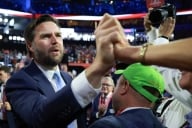You have /5 articles left.
Sign up for a free account or log in.
WASHINGTON — Twenty-three percent of college presidents in the United States are female. A group of four influential female presidents gathered at the National Archives here Thursday evening and argued that this percentage should be much higher, so as to mirror the majority female student population in higher education.
The presidents — H. Kim Bottomly of Wellesley College, Catharine Bond Hill of Vassar College, S. Georgia Nugent of Kenyon College and Teresa A. Sullivan of the University of Virginia — spoke on a panel about “the changing roles of women in academic leadership” for the Archives’ 4th Annual Forum on Women in Leadership. All concurred with the notion that the percentage of female presidents should match the percentage of female students in higher education.
“Faculty, administration and staff levels should represent what the student body looks like,” Bottomly said. “If 57 percent of the student bodies are women, then there ought to be female faculty members equivalent to that…. That should be true for men and women of color, too.”
Of the 2148 institutions of higher education in the United States, only 494 have female presidents, noted Donne G. Kampel, panel moderator and associate dean of faculty at Touro College, in New York City. Earlier this month, she published Learning Leaderships: Women Presidents of Colleges and Universities (Lambert Academic Publishing). Kampel also noted that, of all the institutional classifications in higher education, community colleges have the highest share of female presidents, at 29 percent.
All of the presidents agreed that there are still barriers that keep women from presidencies.
Bottomly explained that the traditional “pipeline” for academic leaders comes from the faculty ranks. She went on to argue that, though there has been some progress in getting women into the faculty ranks, presidents and provosts need to take a more “active” role in looking for the female administrative “stars” and “talent” of tomorrow. Simply having more women in the faculty ranks is not enough, she added.
Nugent explained that the term “glass ceiling,” which people often apply to the nebulous barrier keeping many women from leadership positions, does not quite apply to higher education.
“In higher education, we have the starry emporium,” Nugent said. “The presidents of Harvard, Brown and Penn are all women. That’s very visible, and it gives a mistaken impression of the progress women have made in higher education.”
The presidents all hesitated when asked about the specific obstacles they faced on the way to the presidency. They chose, instead, to offer some advice to any women seeking a future in academic leadership.
“You can’t be someone who dwells on those things,” said Nugent, referring to an instance when, as a faculty member at Brown, she took offense when a male colleague asked her, one of the few women present, to take minutes at a meeting.
Bottomly and Hill suggested that women seek out leadership roles on powerful committees and not simply on ones where their membership is sought out.
“Go out and search for them,” Hill said. “Say ‘no’ to the ones you think are pushing you in a direction you don’t want to go…. Be on the finance committee. Don’t be on the — this is going to sound awful but — childcare committee.… You have to be willing to take on things and be risk-seeking in a kind of way.”
The 200-seat theater at the Archives was nearly full for the event, and an audience of mostly young women (including many alumnae of the four institutions represented) sought more advice from the presidents afterward in a question-and-answer session.
Sullivan, who is still in the first year of her presidency, offered some of the most direct advice of the evening to would-be female presidents: have the last word.
“If any of you have read Deborah Tannen, then you know that men interrupt women a lot,” said Sullivan, referencing the Georgetown University linguistics professor's work, including the best-selling You Just Don’t Understand: Women and Men in Conversation (Harper Paperbacks). “You have to have the sound bite at the end of the conversation. You have to say things succinctly.”








